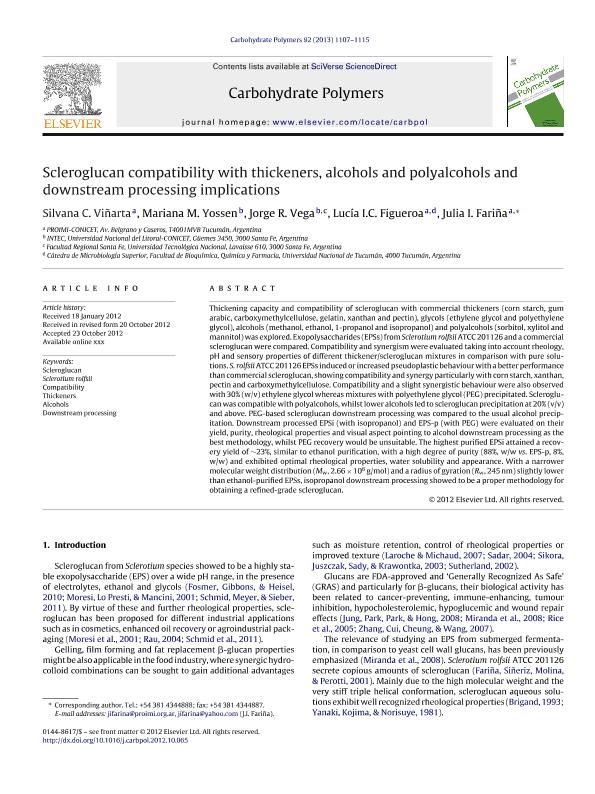Mostrar el registro sencillo del ítem
dc.contributor.author
Viñarta, Silvana Carolina

dc.contributor.author
Yossen, Mariana Matilde

dc.contributor.author
Vega, Jorge Ruben

dc.contributor.author
Castellanos de Figueroa, Lucia Ines

dc.contributor.author
Fariña, Julia Inés

dc.date.available
2015-08-24T14:42:54Z
dc.date.issued
2013-02
dc.identifier.citation
Viñarta, Silvana Carolina; Yossen, Mariana Matilde; Vega, Jorge Ruben; Castellanos de Figueroa, Lucia Ines; Fariña, Julia Inés; Scleroglucan compatibility with thickeners, alcohols and polyalcohols and downstream processing implications; Elsevier; Carbohydrate Polymers; 92; 2; 2-2013; 1107-1115
dc.identifier.issn
0144-8617
dc.identifier.uri
http://hdl.handle.net/11336/1780
dc.description.abstract
Thickening capacity and compatibility of scleroglucan with commercial thickeners (corn starch, gum arabic, carboxymethylcellulose, gelatin, xanthan and pectin), glycols (ethylene glycol and polyethylene glycol), alcohols (methanol, ethanol, 1-propanol and isopropanol) and polyalcohols (sorbitol, xylitol and mannitol) was explored. Exopolysaccharides (EPSs)from Sclerotium rolfsiiATCC 201126 and a commercial scleroglucan were compared. Compatibility and synergism were evaluated taking into account rheology, pH and sensory properties of different thickener/scleroglucan mixtures in comparison with pure solutions. S. rolfsii ATCC 201126 EPSs induced or increased pseudoplastic behaviour with a better performance than commercial scleroglucan, showing compatibility and synergy particularly with corn starch, xanthan, pectin and carboxymethylcellulose. Compatibility and a slight synergistic behaviour were also observed with 30% (w/v) ethylene glycol whereas mixtures with polyethylene glycol (PEG) precipitated. Scleroglucan was compatible with polyalcohols, whilstlower alcohols led to scleroglucan precipitation at 20% (v/v) and above. PEG-based scleroglucan downstream processing was compared to the usual alcohol precipitation. Downstream processed EPSi (with isopropanol) and EPS-p (with PEG) were evaluated on their yield, purity, rheological properties and visual aspect pointing to alcohol downstream processing as the best methodology, whilst PEG recovery would be unsuitable. The highest purified EPSi attained a recovery yield of ∼23%, similar to ethanol purification, with a high degree of purity (88%, w/w vs. EPS-p, 8%, w/w) and exhibited optimal rheological properties, water solubility and appearance. With a narrower molecular weight distribution (Mw, 2.66 × 106 g/mol) and a radius of gyration (Rw, 245 nm) slightly lower than ethanol-purified EPSs, isopropanol downstream processing showed to be a proper methodology for obtaining a refined-grade scleroglucan.
dc.format
application/pdf
dc.language.iso
eng
dc.publisher
Elsevier

dc.rights
info:eu-repo/semantics/openAccess
dc.rights.uri
https://creativecommons.org/licenses/by-nc-sa/2.5/ar/
dc.subject
ALCOHOLS
dc.subject
COMPATIBILITY
dc.subject
DOWNSTREAM PROCESSING
dc.subject
SCLEROGLUCAN
dc.subject
SCLEROTIUM ROLFSII
dc.subject
THICKENERS
dc.subject.classification
Bioquímica y Biología Molecular

dc.subject.classification
Ciencias Biológicas

dc.subject.classification
CIENCIAS NATURALES Y EXACTAS

dc.title
Scleroglucan compatibility with thickeners, alcohols and polyalcohols and downstream processing implications
dc.type
info:eu-repo/semantics/article
dc.type
info:ar-repo/semantics/artículo
dc.type
info:eu-repo/semantics/publishedVersion
dc.date.updated
2016-03-30 10:35:44.97925-03
dc.journal.volume
92
dc.journal.number
2
dc.journal.pagination
1107-1115
dc.journal.pais
Países Bajos

dc.journal.ciudad
Amsterdam
dc.description.fil
Fil: Viñarta, Silvana Carolina. Consejo Nacional de Investigaciones Científicas y Técnicas. Centro Científico Tecnológico Conicet - Tucumán. Planta Piloto de Procesos Industriales Microbiológicos; Argentina
dc.description.fil
Fil: Yossen, Mariana Matilde. Consejo Nacional de Investigaciones Científicas y Técnicas. Centro Científico Tecnológico Conicet - Santa Fe. Instituto de Desarrollo Tecnológico para la Industria Química. Universidad Nacional del Litoral. Instituto de Desarrollo Tecnológico para la Industria Química; Argentina
dc.description.fil
Fil: Vega, Jorge Ruben. Consejo Nacional de Investigaciones Científicas y Técnicas. Centro Científico Tecnológico Conicet - Santa Fe. Instituto de Desarrollo Tecnológico para la Industria Química. Universidad Nacional del Litoral. Instituto de Desarrollo Tecnológico para la Industria Química; Argentina. Universidad Tecnológica Nacional. Facultad Regional Santa Fe; Argentina
dc.description.fil
Fil: Castellanos de Figueroa, Lucia Ines. Universidad Nacional de Tucumán. Facultad de Bioquímica, Química y Farmacia; Argentina. Consejo Nacional de Investigaciones Científicas y Técnicas. Centro Científico Tecnológico Conicet - Tucumán. Planta Piloto de Procesos Industriales Microbiológicos; Argentina
dc.description.fil
Fil: Fariña, Julia Inés. Consejo Nacional de Investigaciones Científicas y Técnicas. Centro Científico Tecnológico Conicet - Tucumán. Planta Piloto de Procesos Industriales Microbiológicos; Argentina
dc.journal.title
Carbohydrate Polymers

dc.relation.alternativeid
info:eu-repo/semantics/altIdentifier/doi/http://dx.doi.org/10.1016/j.carbpol.2012.10.065
dc.relation.alternativeid
info:eu-repo/semantics/altIdentifier/url/http://www.sciencedirect.com/science/article/pii/S0144861712010934
Archivos asociados
